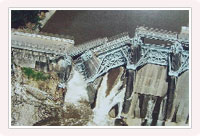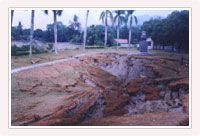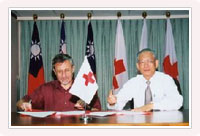Evolution of Disaster Preparedness
921 Earthquake: turning point for disaster preparedness

A 7.3 Richter scale earthquake struck Jiji, a rural township in Nantou Country, Taiwan, at 01:47 on September 21, 1999. 2,506 were killed or missing, 11,306 were injured and 106,685 households collapsed or had partially collapsed, causing heavy losses island-wide. A total of 390,454 disaster-stricken victims were documented. During the worst disaster in Taiwanese history, the Red Cross stepped up to combine resources at home and abroad to assist the government in assuming responsibility for disaster rescue and relief. The impact of this disaster also led the Society to realize the importance of and the need to establish an effective disaster preparedness and response system and related procedures.
Learning from disaster, growing from experience

After conferring with the Danish Red Cross consultant at the end of 2001, the Society began organizing disaster preparedness and organizational development plans with the remaining donations from the 921 Earthquake Rehabilitation Fund. This project spanned a four-year period from June 1, 2002 to December 31, 2005 and was executed in five phases.
Disaster Preparedness & Organizational Development Project

After conferring with the Danish Red Cross consultant at the end of 2001, the Society began organizing disaster preparedness and organizational development plans with the remaining donations from the 921 Earthquake Rehabilitation Fund. This project spanned a four-year period from June 1, 2002 to December 31, 2005 and was executed in five phases.
Project goals included:
- Set-up Disaster Preparedness Centers and construct a network between Red Cross HQ and branches.
- Establish management and utilization guidelines to improve disaster preparedness and relief efficiency.
- Further recruit volunteers to conduct disaster preparedness training.
- Create and issue disaster preparedness manuals and training guides.
- Train seed instructors to strengthen the dissemination of Red Cross knowledge.
- Establish professional action teams (relief task forces).
Concrete results are as follows:
- Completed the Relief and Disaster Preparedness Operations Manual, which outlines cooperation and disaster preparedness mechanisms between Red Cross HQ and its branches.
- Established 25 Disaster Preparedness Centers.
- Red Cross personnel training: conducted disaster management training for full-time staff, volunteer training in basic search-and-rescue and disaster preparedness, and completed disaster preparedness guidelines and teaching materials.
- Established professional action teams (search-and-rescue teams).
- In addition to existing onshore emergency, home services and water safety rescue volunteer teams, further established relief (disaster) teams, youth service teams and community service teams to strengthen volunteer manpower and implement community service.
